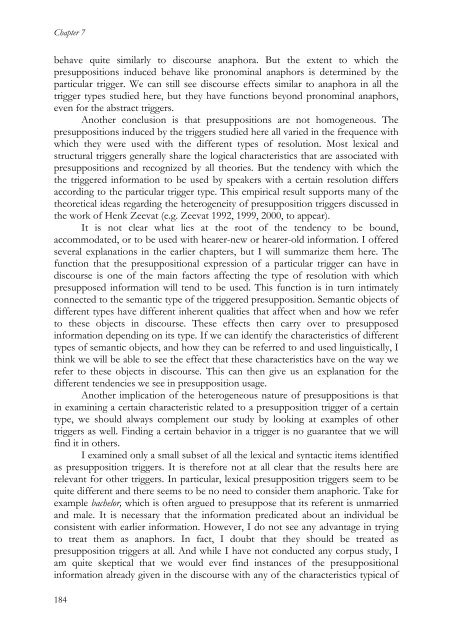Presuppositions in Spoken Discourse
Presuppositions in Spoken Discourse
Presuppositions in Spoken Discourse
You also want an ePaper? Increase the reach of your titles
YUMPU automatically turns print PDFs into web optimized ePapers that Google loves.
Chapter 7<br />
behave quite similarly to discourse anaphora. But the extent to which the<br />
presuppositions <strong>in</strong>duced behave like pronom<strong>in</strong>al anaphors is determ<strong>in</strong>ed by the<br />
particular trigger. We can still see discourse effects similar to anaphora <strong>in</strong> all the<br />
trigger types studied here, but they have functions beyond pronom<strong>in</strong>al anaphors,<br />
even for the abstract triggers.<br />
Another conclusion is that presuppositions are not homogeneous. The<br />
presuppositions <strong>in</strong>duced by the triggers studied here all varied <strong>in</strong> the frequence with<br />
which they were used with the different types of resolution. Most lexical and<br />
structural triggers generally share the logical characteristics that are associated with<br />
presuppositions and recognized by all theories. But the tendency with which the<br />
the triggered <strong>in</strong>formation to be used by speakers with a certa<strong>in</strong> resolution differs<br />
accord<strong>in</strong>g to the particular trigger type. This empirical result supports many of the<br />
theoretical ideas regard<strong>in</strong>g the heterogeneity of presupposition triggers discussed <strong>in</strong><br />
the work of Henk Zeevat (e.g. Zeevat 1992, 1999, 2000, to appear).<br />
It is not clear what lies at the root of the tendency to be bound,<br />
accommodated, or to be used with hearer-new or hearer-old <strong>in</strong>formation. I offered<br />
several explanations <strong>in</strong> the earlier chapters, but I will summarize them here. The<br />
function that the presuppositional expression of a particular trigger can have <strong>in</strong><br />
discourse is one of the ma<strong>in</strong> factors affect<strong>in</strong>g the type of resolution with which<br />
presupposed <strong>in</strong>formation will tend to be used. This function is <strong>in</strong> turn <strong>in</strong>timately<br />
connected to the semantic type of the triggered presupposition. Semantic objects of<br />
different types have different <strong>in</strong>herent qualities that affect when and how we refer<br />
to these objects <strong>in</strong> discourse. These effects then carry over to presupposed<br />
<strong>in</strong>formation depend<strong>in</strong>g on its type. If we can identify the characteristics of different<br />
types of semantic objects, and how they can be referred to and used l<strong>in</strong>guistically, I<br />
th<strong>in</strong>k we will be able to see the effect that these characteristics have on the way we<br />
refer to these objects <strong>in</strong> discourse. This can then give us an explanation for the<br />
different tendencies we see <strong>in</strong> presupposition usage.<br />
Another implication of the heterogeneous nature of presuppositions is that<br />
<strong>in</strong> exam<strong>in</strong><strong>in</strong>g a certa<strong>in</strong> characteristic related to a presupposition trigger of a certa<strong>in</strong><br />
type, we should always complement our study by look<strong>in</strong>g at examples of other<br />
triggers as well. F<strong>in</strong>d<strong>in</strong>g a certa<strong>in</strong> behavior <strong>in</strong> a trigger is no guarantee that we will<br />
f<strong>in</strong>d it <strong>in</strong> others.<br />
I exam<strong>in</strong>ed only a small subset of all the lexical and syntactic items identified<br />
as presupposition triggers. It is therefore not at all clear that the results here are<br />
relevant for other triggers. In particular, lexical presupposition triggers seem to be<br />
quite different and there seems to be no need to consider them anaphoric. Take for<br />
example bachelor, which is often argued to presuppose that its referent is unmarried<br />
and male. It is necessary that the <strong>in</strong>formation predicated about an <strong>in</strong>dividual be<br />
consistent with earlier <strong>in</strong>formation. However, I do not see any advantage <strong>in</strong> try<strong>in</strong>g<br />
to treat them as anaphors. In fact, I doubt that they should be treated as<br />
presupposition triggers at all. And while I have not conducted any corpus study, I<br />
am quite skeptical that we would ever f<strong>in</strong>d <strong>in</strong>stances of the presuppositional<br />
<strong>in</strong>formation already given <strong>in</strong> the discourse with any of the characteristics typical of<br />
184











